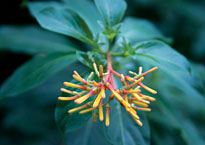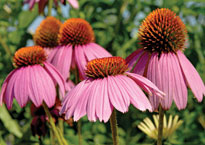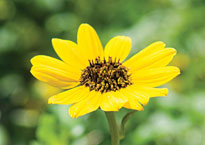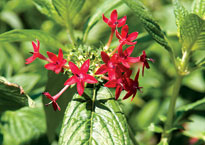The "Blooms" portion of the exhibition features nectar plants such as red star cluster (Pentas lanceolata), porterweed (Stachytarpheta sp.), spicy jatropha (Jatropha integerrima), sweet almond verbena (Aloysia virgata), Mayan spinach tree (Cnidoscolus chayamansa), Panama rose (Rondeletia leucophylla), plumed celosia (Celosia argentea), lantana (Lantana camara), golden dewdrop (Duranta erecta), tropical sage (Salvia sp.), and many more. Information on a selection of these plants can be found below. View Gardening for Butterflies or Butterfly Garden Resources for information on creating your own midwestern butterfly garden.

Aloysia virgata
Sweet almond verbena, incense bush
Sweet Almond (Aloysia virgata) is a bloom-covered, upright shrub which can be trained as a tree warmer climates, reaching 15 feet in height. Its slightly weeping branches end in host a of blooms with a heavenly scent which permeates the garden and attracts pollen and nectar-gatherer from afar. This everblooming Argentine native prefers full sun, and while a fast grower, can be pruned and maintained at a size of 2 to 3 feet with care. It can cause allergic dermatitis in sensitive individuals.

Jatropha integerrima 'Compacta'
Peregrina, Compact spicy jatropha
Japtropha integerrima 'Compacta', commonly known as compact spicy jatropha, produces showy, bright-pink flowers throughout most of the year. This "compact" selection features shortened internodes (the length of stem between the buds) resulting in a large shrub (versus a medium-sized tree for the straight species). Compare and contrast the very succulent-appearing Jatropha podagricea in the Arid Greenhouse with this species from the relatively moist island of Cuba. Like almost all members of the Euphorbiaceae family, this plant's sap contains a white latex substance that is a skin irritant and can be poisonous if swallowed.

Hamelia patens
Firebush, hummingbird bush
Hamelia patens is a large perennial shrub in the Rubiaceae family, native to the American subtropics and tropics, where its ubiquitous appearance in all kinds of growing conditions may earn it the label of "weed". Its range extends from Texas to Florida in the southern United States, to as far south as Argentina. It typically makes a 4- to 5-foot mound of tubular, reddish-orange flowers from early summer until late fall. While not aromatic at all, firebush is known to have a variety of medicinal uses, and is commonly used in regional medicine to treat skin diseases including rashes, skin fungus, sores and insect stings, and even as a wash to treat foot odor or athelete's foot.
Hamelia patens is very drought tolerant — in fact, the hotter it gets, the better the plant seems to do. In the summer landscape garden, use it in sunny, well-drained spots for maximum flowering. Pruning at the end of the flowering season is recommended in southern climates, to keep the plant from reaching an unwieldy size. Firebush is typically a greenhouse plant in midwestern climates.

Hylotelephium spectabile
Showy stonecrop
Showy sedum is the cultivar of the large-flowered, herbaceous, perennial sedums that comes closest to a true red flower color. Growing 18 x 18 inches, this fall-blooming perennial thrives in average soils with average water. The blooms are a butterfly magnet.
Hylotelephium used to be called sedum until the DNA was analyzed. Both genera remain members of the Crassulaceae, which were the first group of plants discovered with the Crassulean Acid Metabolism (CAM) approach to photosynthesis. For those not familiar with the process, water (H2O) plus carbon dioxide (CO2) in the presence of light within a chloroplast (containing enzymes) produces sugars (multiples of CH2O) used to supply energy for plant cells. In CAM plants, some of the chemical processes are delayed until the sun goes down and the danger of transpiring (equivalent to perspiring and breathing combined in people) is less likely to result in the loss of large quantities of water.

Gaura lindheimeri
Butterfly gaura
Gaura lindheimeri is a bushy, clump forming gaura from the southern United States. Its long panicles (up to 2 feet) end in a host of tiny 1-inch white flowers which fade to pink as the bloom ages. Grown as a perennial in USDA zones 6 through 9, it is usually planted as an annual in Chicago's midwestern climate.
The genus name is derived from the Greek gauros (superb) in reference to the flowers. The genus contains about 21 species of annuals and perennials native to North America, and is a member of the evening primrose family (Onagraceae). This family contains between 640 to 650 species, and is widespread on every continent (except Antarctica) from boreal to tropical climates. The genus Fuchsia is the most frequent member of this family grown in gardens.

Bulbine frutescens
Shrubby bulbine
This fast-growing succulent member of the Liliaceae family bears bright yellow, star-shaped flowers on racemes borne 2 to 3 feet above lance-shaped, blue-green basal leaves. Growing 10 to 12 stalks per individual 1 foot tall by 1 foot wide plant, Bulbine frutescens blooms continually from mid-spring through fall. A native South African perennial, it is grown as an annual or greenhouse plant in cooler climates, spreading by rhizomes into new plants. Hummingbirds and bees love it, and once established, it tolerates drought well.
Bulbines are also known as "burn jelly plant." Glycoproteins contained in their leaves, (similar to many aloe species) are touted for healing properties in treating burns, rashes, and a variety of skin conditions. Extracts from the plant are used in microporous tape used to reduce incision scarring. A gel in the tape increases hydration by leaving a layer of fatty vesicles of glycoprotein on the skin surface. The extract also has antibacterial properties.

Lantana camara 'Citrus Blend'
Lantana, verbena
Citrus Blend lantana features two-tone flowers beginning mid-summer and extending up to frost. It flowers best when grown in full sun and dryish soils with low fertilization. The flowers are beloved by butterflies and hummingbirds, and songbirds cherish the ripe fruit, but the foliage can cause photo-induced dermatitis in herbivores — consequently, it is avoided by deer and rabbits.
The species Lantana camara was described by Carolus Linnaeus in 1753, and has a native range that extends from south Texas through Mexico, and the Caribbean to Brazil. A member of the Verbenaceae, it, like other members of this family, contains a host of chemicals with various toxic and medicinal uses. In tropical climates outside of its native range, it has become invasive. Only hardy to freezing, it reliably dies out each year in the Chicago region.

Salvia coccinea
Hummingbird sage
Hummingbird sage (Salvia coccinea) is an erect, bushy plant diplaying spikes of soft, red flowers from late summer to early fall. Growing 24 to 30 inches tall, it prefers full sun and average soils. Grown as an annual in cooler zones, this sage reseeds and spreads freely. It is deer resistant and will tolerate salt spray and salty soil.

Pseudogynoxys chenopodioides
Mexican flame vine
Pseudogynoxys chenopodioides was much easier to remember under its old name of Senecio confusus. In retrospect, the species name of confusus should have been a strong hint that not all was well in taxonomy land. Regardless, this arid-zone-adapted vine grows to 10 feet or more, producing very smelly (scientists use the term "foetid"), bright orange, sunflower-shaped flowers. Handsome, dark green, arrow-shaped leaves provide a great backdrop for the flowers. Full sun, moderate water and fertilization, and a trellis or shrub to clamber over is all it needs.

Echinacea purpurea
Purple coneflower
This quintessential midwestern native dots prairies from Illinois to Virginia, and Louisiana to Georgia. A popular, easily grown, drought-tolerant plant, Echinacea prefers full sun and well-drained soil, and attracts beneficial insects to the garden, including butterflies and soldier beetles. Hard from USDA zones 3 through 9, this perennial can grow up to 5 feet tall with a 2 foot spread in optimal conditions.
Traditionally used to treat a range of infections and malignancies, the roots and herb (above ground parts) of echinacea species are purported to have "immune stimulant" properties and can be found in many dietary supplements.

Monarda fistulosa
Bee balm, wild bergamot
Prairie Gypsy beebalm (Monarda 'Prairie Gypsy') has raspberry-pink flowers on 2-foot stems that also feature aromatic foliage. This native plant is a butterfly and hummingbird attractant, but not so beloved by deer. Grow in full sun in moderately fertile, moist soils, with space between this plant and others to decrease the incidence of powdery mildew.

Helianthus debilis
Cucumberleaf sunflower
Like other sunflowers, this cultivar thrives in full sun with adequate fertilization and a well-drained soil.
Sunflowers of all kinds are beloved by a number of species of native (and exotic) birds; perhaps the most colorful are the Golden Finches. Thousands of acres worldwide are planted annually in sunflowers for oil production. Although the plant is a native of the United States, sunflower oil was first produced in Imperial Russia in 1835. The oil has been used for food, frying oil, in cosmetics, and to protect the skin of premature infants from infections.

Stokesia laevis
Stokes' aster
The only species in the genus Stokesia (a member of the Asteraceae family), this southeastern North American native is an easy to grow perennial which tolerates a variety of soil conditions and flowers with long lasting, shaggy, cornflower-like lavender to blue blooms of 3 to 4 inches each. Blooming begins in late spring and lasts until frost. The deep green basal leaves are evergreen, and add a lush highlight to the garden border. Rather unfortunately, Stokesia laevis is also loved by rabbits.
Stokesia grows from 1 to 2 feet tall, and is winter hardy from USDA zones 5 through 9. It has commercial applications as well — the seeds of this plant contain large amounts of vernolic acid, used in the production of adhesives, varnishes, and plastics.
It is named after Jonathan Stokes (1755–1831), English botanist, and member of the Lunar Society of Birmingham, England.

Buddleja davidii
Butterfly bush
Butterfly bush (Buddleja davidii) is known as a dieback shrub in the Chicago area. Its branches die to the ground during severe winters, but its crown remains alive, ready to send up 3- to 6-foot new stems in late spring. From July to frost, different cultivars produce pink, red, purple, white and even yellow, conical blossoms that butterflies find irresistible. The Garden especially recommends 'Black Knight', 'Nanho Blue', 'Nanho Purple', 'Pink Delight' and 'White Profusion'.

Pentas lanceloata
Star flower, star cluster
This woody-based, evergreen, tropical perennial is a favored nectaring plant by many tropical butterflies. Cultivars available in red, pink, magenta, blue, lilac, or white with elliptical, slightly hairy leaves bear clusters of nectar-rich, half-inch blooms from spring through autumn. Pentas grows 2 to 3 feet in height and width, does well in average soil with full to partial sun, and is winter hardy in USDA zones 10 and 11. It can also be grown as a houseplant, but care must be taken to avoid pests such as whitefly or spider mites.

